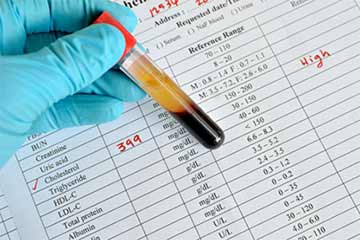Rabies
Rabies is a preventable viral disease of mammals most often transmitted through the bite of a rabid animal.
The vast majority of rabies cases reported to the Centers for Disease Control and Prevention (CDC) each year occur in wild animals like raccoons, skunks, bats, and foxes.
The rabies virus infects the central nervous system, ultimately causing disease in the brain and death.
The early symptoms of rabies in people are similar to that of many other illnesses, including fever, headache, and general weakness or discomfort.
As the disease progresses, more specific symptoms appear and may include insomnia, anxiety, confusion, slight or partial paralysis, excitation, hallucinations, agitation, hypersalivation (increase in saliva), difficulty swallowing, and hydrophobia (fear of water). Death usually occurs within days of the onset of these symptoms.
The rabies virus is transmitted through saliva or brain/nervous system tissue. You can only get rabies by coming in contact with these specific bodily excretions and tissues.
It's important to remember that rabies is a medical urgency but not an emergency. Decisions should not be delayed.
Wash any wounds immediately. One of the most effective ways to decrease the chance for infection is to wash the wound thoroughly with soap and water.
See your doctor for attention for any trauma due to an animal attack before considering the need for rabies vaccination.
Your doctor, possibly in consultation with your state or local health department, will decide if you need a rabies vaccination.
Decisions to start vaccination, known as postexposure prophylaxis (PEP), will be based on your type of exposure and the animal you were exposed to, as well as laboratory and surveillance information for the geographic area where the exposure occurred.
In the United States, postexposure prophylaxis consists of a regimen of one dose of immune globulin and four doses of rabies vaccine over a 14-day period.
Rabies immune globulin and the first dose of rabies vaccine should be given by your health care provider as soon as possible after exposure.
Additional doses or rabies vaccine should be given on days 3, 7, and 14 after the first vaccination. Current vaccines are relatively painless and are given in your arm, like a flu or tetanus vaccine.
The only well-documented cases of rabies caused by human-to-human transmission occurred among eight recipients of transplanted corneas, and among three recipients of solid organs.
Guidelines for acceptance of suitable cornea and organ donations, as well as the rarity of human rabies in the United States, reduce this risk.
In addition to transmission from cornea and organ transplants, bite and non-bite exposures inflicted by infected humans could theoretically transmit rabies, but no such cases have been documented.
Casual contact, such as touching a person with rabies or contact with non-infectious fluid or tissue (urine, blood, feces) does not constitute an exposure and does not require postexposure prophylaxis.
In addition, contact with someone who is receiving rabies vaccination does not constitute rabies exposure and does not require postexposure prophylaxis.
What materials can spread rabies?
Rabies virus is transmitted through saliva and brain/nervous system tissue. Only these specific bodily excretions and tissues transmit rabies virus. If contact with either of these has occurred, the type of exposure should be evaluated to determine if postexposure prophylaxis is necessary.
Contact such as petting or handling an animal, or contact with blood, urine or feces does not constitute an exposure. No postexposure prophylaxis is needed in these situations.
Rabies virus becomes noninfectious when it dries out and when it is exposed to sunlight. Different environmental conditions affect the rate at which the virus becomes inactive, but in general, if the material containing the virus is dry, the virus can be considered noninfectious.
What kind of animal did you come in contact with?
Any mammal can get rabies. The most common wild reservoirs of rabies are raccoons, skunks, bats, foxes, and coyotes. Domestic mammals can also get rabies. Cats, cattle, and dogs are the most frequently reported rabid domestic animals in the United States.
You should seek medical evaluation for any animal bite. One important factor in deciding if you should have postexposure prophylaxis will be if the animal can be found and held for observation.
What type of exposure occurred?
Rabies is transmitted only when the virus is introduced into a bite wound, open cuts in skin, or onto mucous membranes such as the mouth or eyes.
Other factors to consider when evaluating a potential rabies exposure include the natural occurence in the area, the biting animal's history and current health status (e.g., abnormal behavior, signs of illness), and the potential for the animal to be exposed to rabies (e.g., presence of an unexplained wound or history of exposure to a rabid animal).
A currently vaccinated dog, cat, or ferret is unlikely to become infected with rabies.
When an exposure has occurred, the likelihood of rabies infection varies with the nature and extent of that exposure. Under most circumstances, two categories of exposure -- bite and nonbite -- should be considered.
Bite
Any penetration of the skin by teeth constitutes a bite exposure. All bites, regardless of body site, represent a potential risk of rabies transmission, but that risk varies with the species of biting animal, the anatomic site of the bite, and the severity of the wound.
Bites by some animals, such as bats, can inflict minor injury and thus be difficult to detect.
Was the bite from a provoked or an unprovoked attack? Bites inflicted on a person attempting to feed or handle an apparently healthy animal should generally be regarded as provoked. If it was an unprovoked attack, that's more likely to indicate that the animal is rabid.
Nonbite
The contamination of open wounds, abrasions, mucous membranes, or theoretically, scratches (potentially contaminated with infectious material from a rabid animal) constitutes a nonbite exposure.
Nonbite exposures from terrestrial animals rarely cause rabies. However, occasional reports of rabies transmission by nonbite exposures suggest that such exposures should be evaluated for possible postexposure prophylaxis administration.
Other contact by itself, such as petting a rabid animal and contact with blood, urine, or feces of a rabid animal, does not constitute an exposure and is not an indication for postexposure vaccination.
What care will I receive?
Wound Care
Regardless of the risk of rabies, bite wounds can cause serious injury such as nerve or tendon laceration and local and system infection. Your doctor will determine the best way to care for your wound, and will also consider how to treat the wound for the best possible cosmetic results.
For many types of bite wounds, immediate gentle irrigation with water or a dilute water povidone-iodine solution has been shown to markedly decrease the risk of bacterial infection.
Wound cleansing is especially important in rabies prevention since, in animal studies, thorough wound cleansing alone without other postexposure prophylaxis has been shown to markedly reduce the likelihood of rabies.
You should receive a tetanus shot if you have not been immunized in ten years. Decisions regarding the use of antibiotics, and primary wound closure should be decided together with your doctor.
Rabies Postexposure Vaccinations
Postexposure Vaccinations
Human Rabies Immune GlobulinPrograms for uninsured and underinsured patients
Rabies postexposure vaccinations consists of a dose of human rabies immune globulin and four doses of rabies vaccine given on the day of the exposure, and then again on days 3, 7, and 14. The vaccine is given in a muscle, usually in the upper arm. This set of vaccinations is highly effective at preventing rabies if given as soon as possible following an exposure.
If a person has previously received postexposure vaccinations or received preexposure vaccinations, only two doses of vaccine (on the day of exposure and then 3 days later) are needed. Human rabies immune globulin is not required. Your doctor and local health department will be able to guide you through the process.
For people who have never been vaccinated against rabies previously, postexposure anti-rabies vaccination should always include administration of both passive antibody and vaccine.
The combination of human rabies immune globulin (HRIG) and vaccine is recommended for both bite and nonbite exposures, regardless of the interval between exposure and initiation of treatment.
People who have been previously vaccinated or are receiving preexposure vaccination for rabies should receive only vaccine.
Adverse reactions to rabies vaccine and immune globulin are not common. Newer vaccines in use today cause fewer adverse reactions than previously available vaccines. Mild, local reactions to the rabies vaccine, such as pain, redness, swelling, or itching at the injection site, have been reported. Rarely, symptoms such as headache, nausea, abdominal pain, muscle aches, and dizziness have been reported. Local pain and low-grade fever may follow injection of rabies immune globulin.
The vaccine should be given at recommended intervals for best results. Talk to your with your doctor or state or local public health officials if you will not be able to have shot at the recommended interval. Rabies prevention is a serious matter and changes should not be made in the schedule of doses.
People cannot transmit rabies to other people unless they themselves are sick with rabies. The prophylaxis you are receiving will protect you from developing rabies, and therefore you cannot expose other people to rabies. You should continue to participate in your normal activities.
Rabies Vaccines and Immunoglobulin Available in the United States
| Type | Name | Route | Indications |
|---|---|---|---|
| Human Diploid Cell Vaccine (HDCV) | Imovax® Rabies | Intramuscular | Preexposure or Postexposure |
| Purified Chick Embryo Cell Vaccine (PCEC) | RabAvert® | Intramuscular | Preexposure or Postexposure |
| Human Rabies Immune Globulin | Imogam® Rabies-HT | Local infusion at wound site, with additional amount intramuscular at site distant from vaccine | Postexposure |
| Human Rabies Immune Globulin | HyperRab TM S/D | Local infusion at wound site, with additional amount intramuscular at site distant from vaccine | Postexposure |
Postexposure Prophylaxis for Non-immunized Individuals
| Treatment | Regimen |
|---|---|
| Wound cleansing | All postexposure prophylaxis should begin with immediate thorough cleansing of all wounds with soap and water. If available, a virucidal agent such as povidine-iodine solution should be used to irrigate the wounds. |
| RIG | If possible, the full dose should be infiltrated around any wound(s) and any remaining volume should be administered IM at an anatomical site distant from vaccine administration. Also, RIG should not be administered in the same syringe as vaccine. Because RIG might partially suppress active production of antibody, no more than the recommended dose should be given. |
| Vaccine | HDCV or PCECV 1.0 mL, IM (deltoid area ), one each on days 0 , 3, 7, and 14. |
Postexposure Prophylaxis for Previously Immunized Individuals
| Treatment | Regimen |
|---|---|
| Wound cleansing | All postexposure prophylaxis should begin with immediate thorough cleansing of all wounds with soap and water. If available, a virucidal agent such as povidine-iodine solution should be used to irrigate the wounds. |
| RIG | RIG should not be administered. |
| Vaccine | HDCV or PCECV 1.0 mL, IM (deltoid area), one each on days 0 and 3. |
Related Articles
-
Rabies
-
Diagnosis
-
Signs and Symptoms of Rabies
-
Rabies Transmision
-
Rabies. Medical Care
-
How Can you Prevent Rabies in Animals.
-
Risk for Pets
Actualizado: 13 de marzo, 2018






